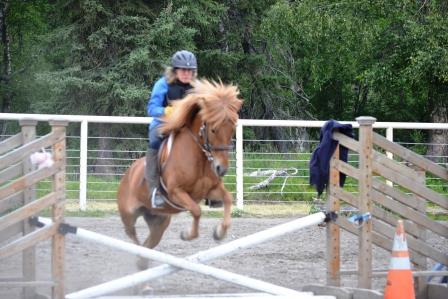
Home > Dispatches > Daily Dispatches 2014 > Daily Dispatch #220
August 15, 2014: Lessons Learned: Prep Work
In “It’s not About the Ribbons,” Jane Savoie suggests that considerably less time can be spent training one’s horse if the person working their animal first visualizes the given activity. So this is what I did before going to lesson. This afternoon, before leaving for Beth’s, I got myself into a relaxed frame of mind by first doing an hour of yoga. Then I did some visualizing on my own. I brought to mind the arena setting, the footing, the weather, the people – and I pictured some of the jumps. I then pictured me on Rosie, what I was wearing, and how she was feeling. I also put to mind mental images of us doing the equitation and jumping portions of the class. |
|
|
We began our lesson by trotting, one behind the other, me, Brandon, Emily, Amanda and Blaine. We then trotted over ground poles, and after that, we trotted and/or cantered over ground poles and a cross jump. (Rosie trotted over the poles, and then picked up a canter a stride before the jump, and after landing, she again picked up a canter.) This repetitive effort was good for us since we both had the opportunity to work on our form. Rosie did not disappoint while doing this exercise, nor did she disappoint when we did diagonal jumps. We were instructed to go over a cavalletti on our left, turn right in a big circle and then jump one, then two cross jumps on the diagonal. We did this several times. Rosie only refused once – the first time – I may have inadvertently looked down. Jumping on Rosie is really a simple preposition. If I err, she who feels unsafe, tells me in a forthright way that our going over the obstacle just does not feel safe to her. This then, is a communicative matter – I must remain confident and self-assured at all times. I knew what I had to do, which is upon approaching the jump, look ahead, past it; going over the jump, I need to continue to keep my heels down, position myself in two point, look up, squeeze with my legs, and grab Rosie’s mane. And before landing, I need to shift my weight slightly to the left or right, squeeze on the left or right or right rein, so as to get her to take up the correct lead and do a canter depart. Then upon landing, I need to urge her to continue cantering. Beth has those who miss jumps or have horses take up the wrong lead do it again. We just had to do the one jump that once. So our getting it right means that we end up conserving energy. This may have been why, at the end, I felt like I could keep going. In the past, when Beth said that we were done, I was only too glad to bow out. This time I felt like I hadn’t had enough. I could not, however, speak for Rosie. I was very pleased with how it all went. In fact, after this lesson I was extremely cocky. This is something that I have to watch, because it could lead to either me or my horse over estimating our abilities. I was, however, pleased to have done so well, and also pleased that others took note. After, Vickie remarked to Pete that upon landing, Rosie took her correct lead consistently. And Brenda said directly to me that it appeared as though I was riding with purpose. The latter is huge. One does not ride with purpose if they’re fearful or lack confidence in their abilities. Beth had first set it up so that the riders first went at a trot over poles, then next jumped one, then two cross poles. After, they were to continue in a straight line over a red ground pole. This wasn’t as easy as it looked, particularly the cross pole part. This is because many of the horses have a tendency to veer off to the right, in the direction of the next jump. What I took note of – set seats, heels in the down position, heads up, attitude of confidence and yes, purpose. All who were in the first group stuck around and watched the seven or so riders in the advanced class. Rather than focus on gaffs, I instead put into mind the things that horse and riders did correctly. This is because my emulating others will instill in my own mind what I’m to do when in a similar situation. On the drive home, I looked at the videos that Pete took on our camera. There I was, on Rosie, going over small and seemingly insignificant cross poles. Heels are down, head is up, there were no refusals. We have quite obviously come a long, long ways – we’re on a roll and things are going to continue in such a fashion. I won’t let myself think otherwise. |
|
